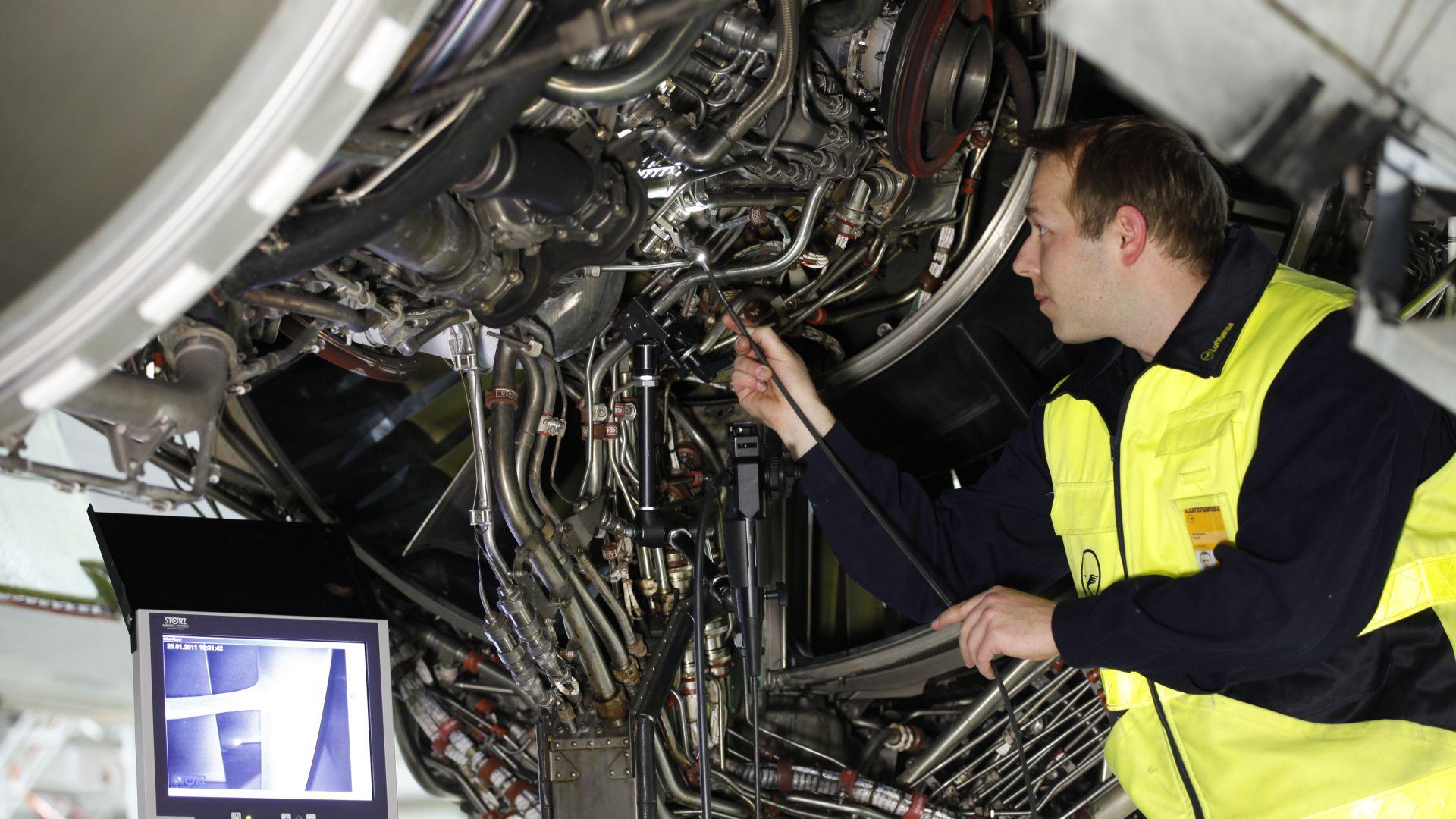
Many aircraft and engine maintenance providers began adding virtual inspection technology in 2020 as a response to COVID-19 travel restrictions. Is this technology here to stay or will MROs phase it out as things return to normal? Read on to find out more about how companies are embracing virtual inspection technologies—and whether they intend to continue doing so in the future.

Leveraging 5G Connectivity
Lufthansa Technik (LHT) was an early adopter of virtual inspection technology, rolling out its virtual table inspection offering in February 2020. The service lets customers remotely attend engine part inspections via a live video stream, where they can communicate in real time with engine mechanics performing the work and inspect the dismantled parts in high resolution. LHT also offers virtual borescope inspections, which are carried out through the MRO Management application on its digital Aviatar platform. Both services leverage LHT’s private 5G wireless network, which enables better data transmission for high-resolution video streams. At present, LHT continues to offer both services.

Saving Time and Money
SR Technics began offering remote table inspections in April 2020, which allow customers to follow along with inspections of engines, modules and parts via high-resolution video recordings on a secure streaming platform. The Swiss MRO is then able to schedule online review meetings with customers to discuss findings, which it says provides an equivalent level of detail as a traditional, in-person table inspection. In addition to being a workaround for pandemic travel restrictions, SR Technics says the service has helped to save time and costs for customers while reducing waiting time bottlenecks.

Remotely Exploring the Engine Shop
AFI KLM E&M subsidiary EPCOR introduced Virtual Table Inspections (VTI) in October 2020, which allow customers to remotely pilot a robot fitted with a camera, speakers, microphones and a magnifying glass around the shop during virtual inspections of auxiliary power units and pneumatic components. According to a spokesperson for EPCOR, customers have responded positively to VTI and have enjoyed the technology as a way to explore the shop—despite its limitations in allowing them to see the smallest damage to parts.
Parent company AFI KLM E&M has adopted the technology to offer VTI and is working with EPCOR through The MRO Lab, its in-house innovation arm, to develop new functionalities for VTI such as extra macro camera, LED lights and improved Bluetooth connections.

Limitations of Virtual Inspections
Although Magnetic MRO introduced virtual inspections in response to the pandemic, it does not expect the technology to remain a primary part of maintenance offerings once the industry normalizes. According to Silver Hunt, airworthiness engineer at Magnetic MRO, virtual inspection technology would need to improve to the point where it can detect details as well as the human eye before it would be preferable to in-person inspections.
"The camera lens will not catch minute details like minor scratches, dents, etc.," says Hunt. "Virtual inspection would be a more cost-effective and faster option, but there’s still a lot of work to be done to have the processes and the technology implemented which would provide the standard needed for it to actually become industry standard."

Digitalizing Interior Inspections
Prior to the pandemic, Magnetic MRO developed an application to digitalize aircraft cabin inspections. The mobile application, called Interior Inspector, enables cabin crew and maintenance teams to log and share data and photos of damage in the passenger cabin on smartphones, tablets or computers.
While Interior Inspector is still available to clients, Magnetic MRO says it has not added any new functionalities following its initial release in 2019, since the need for interior refurbishments dropped due to the COVID-19 pandemic.

Remotely Controlled Cabin Inspections
Airbus subsidiary Testia says interest in its Remote Assistance software increased greatly during COVID-19. The software allows users working from home to connect with technicians in facilities using live video communication and capabilities such as being able to draw on-screen. During the pandemic, Airbus began testing the software’s use within its DigIn (Digital Inspection) project, which aims to make the cabin inspection process precertification more flexible.
In June 2020, the company completed its first remotely controlled cabin inspection using the Remote Assistance software. A remotely located airworthiness engineer was able to evaluate an A320neo aircraft cabin through a live video stream and relay instructions to a colleague on site. Testia says Airbus is now working to adapt the concept for other purposes within different groups.

Virtual Remote Audits
AAR was testing technologies such as augmented reality (AR) wearables prior to the pandemic, so it used some of these capabilities to adapt to COVID-19 constraints. By combining RealWear HMT-1 headsets and Librestream’s AR platform, it was able to conduct remote audits with the FAA at various facilities despite travel restrictions. While AAR says it has seen a reduction in virtual remote audits as businesses reopen, it will still look to the technology to augment its surveillance for corporate audits.
“As we move toward paperless environments, we see a use for virtual inspections and virtual job evaluations on nonroutine maintenance,” says Art Smith, AAR vice president and chief quality officer. “Other applications for virtual uses would be in warehouses for incoming/outgoing inspections and possible exporting parts.”

Hands-Free Headgear
During the pandemic HAECO introduced remote inspection technology consisting of voice-controlled goggles paired with a communication interface accessible via computer or mobile device. Mechanics or inspectors are able to use the hands-free goggles to follow digital workflows, take photos, share files, capture field data and collaborate in real time with remote experts.
HAECO recently completed an on-wing nacelle modification using the system in Hong Kong in collaboration with an OEM. It is continuing to leverage remote inspection technology in other aircraft maintenance projects, and HAECO Group Chief Commercial Officer Richard Kendall says he believes the technology will bring value post-COVID.

Augmenting Inspections with AI
Engine MRO provider MTU Maintenance invested in multiple technology projects during the pandemic, including the use of technology to enhance remote inspections. MTU is using artificial intelligence (AI) software from startup Aiir Innovations to speed up and improve engine borescope inspections. The software analyzes borescope inspection video footage to identify areas of damage more efficiently and point inspectors to the correct areas. MTU is able to share these AI-verified videos with customers through an online portal and it is working on a livestream feature.

Virtual Inspection Training
The pandemic accelerated technology projects at Rolls-Royce related to digitalizing engine inspections. It has used the Librestream Onsight Connect AR platform throughout the pandemic, to train customers on how to inspect engines, in lieu of specialist inspectors flying to a customer location. The platform enabled trainees to share engine inspection images and collaborate with Rolls-Royce in real time, which it says helped to avoid multiple aircraft-on-ground situations. The company is currently looking at using the Librestream platform to carry out more complex inspections.

Intelligent Borescope Inspections
Rolls-Royce has also rolled out an Intelligent Borescope service that uses artificial intelligence (AI) to reduce the time it takes to complete engine borescope inspections. It is launching the first of its three AI apps this year, which will map engine turbine blades to identify irregularities. It says the technology has reduced the data processing time needed for some inspections from 90 min. to just 10 min.

Robotic Aircraft Inspections
Nondestructive testing (NDT) specialist IMITec introduced a remote-controlled aircraft inspection device in late 2019 that detects aircraft damage without needing an on-site certified NDT inspector. The device is comprised of a climbing robot that attaches to an aircraft’s structure using a vacuum technique and scans areas of interest while guided by a remote operator, as well as accompanying software.
The device gained traction in 2020 and is now being used by Swiss International Airlines for line maintenance applications, such as inspection of dents on the wing and fuselage. In the last nine months, IMITec has improved the device’s remote communication functionality and developed an updated version, which will be launching in September at London City Airport.

Other Remote Inspection Offerings
Several other MROs and OEMs offered remote inspection technology prepandemic or introduced the offering in 2020. This includes Safran’s B.SIde remote borescope inspection service as well as GA Telesis’ Remote Table Inspection Solution and Extended Reality Remote Inspection Solution. Both companies declined to comment about whether the technologies are still in use or whether there would be investment into new functionalities and use cases for remote inspections.
MROs embraced virtual technology to provide inspections to customers remotely during the COVID-19 pandemic. Is this practice here to stay?
